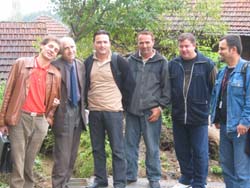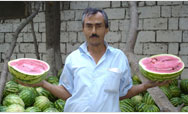You are here » Home » Telling Our Story
Success Story
Different ethnic groups
work together to solve
local infrastructure
problems
Rebuilding Communities Together

| |
Photo: Gojko Ilic, Mercy Corps
|
|
Six men worked on the Hoqe e
Madhe/Velika Hoca road project, part
of an effort to improve the community’s
infrastructure.
“We welcome everybody to
come back and live
together.”
— Esat Haxhijaha,
mayor of Rahovec/
Orahovec.
|
The satisfaction of a job well done was apparent in the faces of the six workers attending the dedication of a newly paved road in the Kosovo village Hoqe e Madhe/Velika Hoca in Rahovec/Orahovec municipality (the Albanian/Serbian names). But also apparent was the pride they felt in having done the job cooperatively, without any ethnic disputes among the crew’s Serbian Kosovars and Albanian Kosovars.
At the road’s dedication, Esat Haxhijaha, the Albanian Kosovar mayor of Rahovec/Orahovec, said to the Serbian Kosovars, “We welcome everybody to come back and live together. We are at the point we have to think for the future.”
After the 1999 conflict, many did not expect to see this level of cooperation among ethnicities. But a USAID initiative is helping communities start working together to solve local problems. With support from USAID, two villages — Hoqe e Madhe/Velika Hoca and Budrige e Ulet/Donja Budriga — have demonstrated that different ethnicities can again work together productively, building critical infrastructure projects and learning how to manage these projects in an participatory way that involves all local residents, officials and authorities.
Designed to facilitate reintegration of minorities into Kosovo through infrastructure rehabilitation, the program helps train communities on how to advocate for their needs with higher officials, how to hold public meetings to determine local priorities, how to conduct an open bidding process and how to manage a project, such as paving a road in Hoqe e Madhe/Velika Hoca or building a school annex in Budrige e Ulet/Donja Budriga. Nebojsa Savic, a Serbian Kosovar member of the community group managing the school project in Budrige e Ulet/Donja Budrige, says the group has learned that being inclusive is the best thing for the project, and for the community. In contract negotiations, “the company must be selected based on its qualifications. We will always give our vote to the best company bidding, even if it is an Albanian [Kosovar] company.”
Print-friendly version of this page (244kb - PDF)
Click here for high-res photo
Back to Top ^ | 

